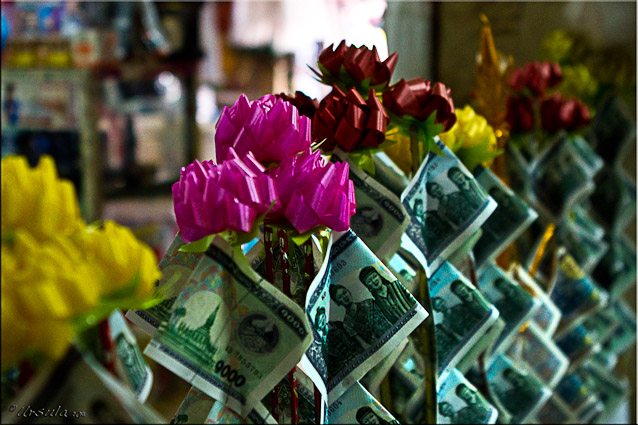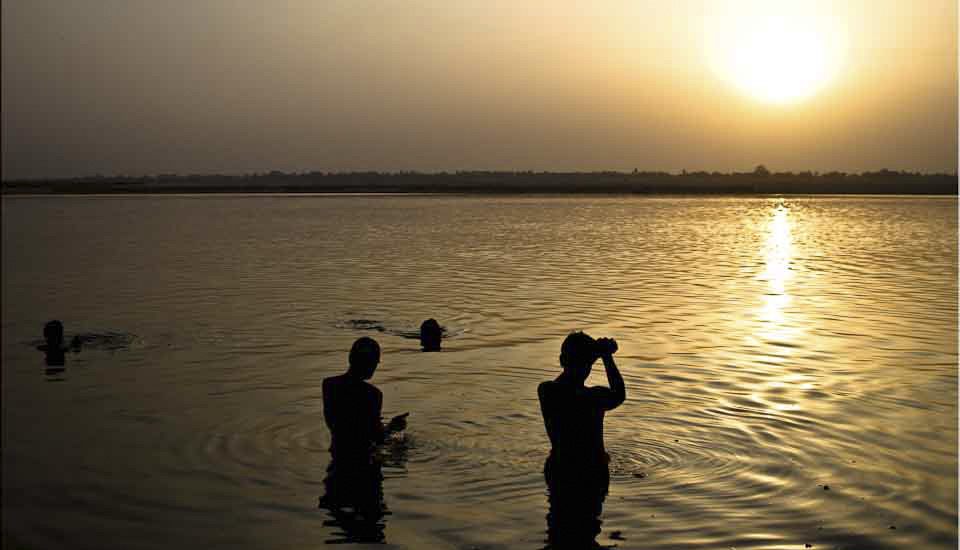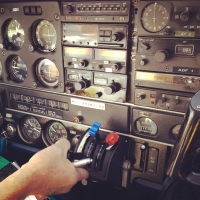Money trees for sale! Why should I be startled?
Morning markets in Asia are a jumble of surprises – people and products rubbing shoulders in unexpected combinations. The morning market in Attapeu, southeastern Laos is a great example: a treasure trove where the nails are next to the make-up and crayons; where you can buy live catfish or invest in the nets to catch your own; where the weak fluorescent lamps can neither illuminate the dark interior corridors nor compete with the brightly angled early sunshine outdoors.

Who said money doesn't grow on trees? These money trees are to offer the local Buddhist temple.
I love morning markets – except for the fact that they are so very early in the morning! I am really not a morning person… but the morning markets in Attapeu, southeastern Laos, start early – very early. By the time I was up and out at 5:30am, this small frontier town at the confluence of the Xe Kong and Xe Kaman rivers was already coming to life. Crossing the rivers on precarious little ferries that look like grass huts on pontoons, vendors and buyers from outlying areas were already arriving in town with their motorcycles, their shopping baskets and their trussed pigs and chickens. Shop keepers with permanent places at the outer edges of the large shelter that comprises part of the market were rolling up their metal doors and organising displays of hanging baskets, clothing and fishing nets.

Coming into Attapeu

Heading from the Ferry to Market

Morning has Broken: Motorcycle coming into Attapeu
As much as I love markets, I do find them challenging – both personally and photographically. I’m not petite, and once I have my ThinkTank around my waist and a camera or two around my neck, I take up a lot of room! Under-cover markets can be dark and crowded, with narrow aisles and a lot of people. They are wet underfoot in places, with boxes, uneven surfaces and other obstructions in others. When it comes to taking pictures, I have difficulty with the low light and high contrasts; as well with the tight spaces. Sometimes, sights and smells can be confronting.

Local Butcher
Food is central to the markets: raw, cooked or still wriggling – everything is right here!

Kitchen Fires

Chicken Little

Portable Take-Away "Food on a Stick" is Everywhere!

Making Banana Fritters for Breakfast

Banana Fritters: Delicious!

Catfish Wriggling

Buffalo Hide for Jerky?
The best part of local markets for me is the insight it gives me into people’s lives, and the opportunity to interact with ‘true’ locals. Laos must be one of the most ethnically diverse countries in the region: Attapeu province alone, with it’s meagre population of 114,000, is home to fifteen ethnic groups, and the local market plays host to many of these. Although there are numerous local languages, most people speak Lao, and between their Lao and my Thai, I can generally have small conversations. The people were engaging, willing to chat and mostly happy to be photographed.

Lao Smiles

Chiildren of Vendors Have to Make Fun Where they Can Find It!

Lao Woman Selling Clothes from Thailand

Local Lao Silk Weaves

Lawee Child

Lao Man

Not Everyone is Happy to be at the Market!

If You Have no Customers, Use the Products Yourself!
Markets can give you a real sense of what is important in people’s lives. My travel companions were in search of woven baskets and silks; the two products that most got my attention were fishing supplies (river fishing is critical to livelihood here) and lumps of white stuff, which I finally worked out were brewers yeast, for making the ubiquitous rice wine!

Wicker and Broom on Main Street, Attapeu

Tiny Metal Weights hang like Tear Drops on the New Nylon Fishnets

Brewers Yeast by the Bag Full - For Rice Wine by the Bucket-Full!

Meat and Fish: Waiting for Customers... (The red face on the woman at the left is a relatively common local condition. We were told it is the consequence of the excessive use of skin-whitening products.)

Mattresses and Motor Oil For Sale in the French Colonial Shop-Houses

Heading to the Ferry With a Supply of Aluminium Pots: Heading Home, or to the Next Market?

.
Until next time ~ Happy Shopping!






























.jpg)


Great interesting report again, nice reportage style of photographs developing too 🙂
Are you sponsored by Thinktank? (lol joking) I use Thinktank stuff too and absolutely love their solutions for travel/street work.
Funny about the language thing, you seem to agree with my findings; that if you are able to speak a reasonable degree of Thai, combined with some words and phrases in Lao/Isaan you pretty much have no problem communicating.
Cheers,
Guava
Hi Guava!
Glad you like the post and pictures. No, ThinkTank don’t pay me, but I do love’em enough to advertise. 🙂
I like the diversity of photos and theme xxx
Fabulous insight into the local communities Ursula… love to you both.
Thanks for visiting and commenting, Signe. I hope it’s getting drier where you are!
Fantastic photos Ursula! Loved the commentary too- started with a bang haha, and very crisp and informative!
Thanks for sending the link
D
Thanks for stopping in, Debbie. I’d love to be able to use humour like you do. 🙂
[…] particular trip, to Attapeu and to the Lawae and Taliang villages in the region, was rich with cultural experiences. But, I […]